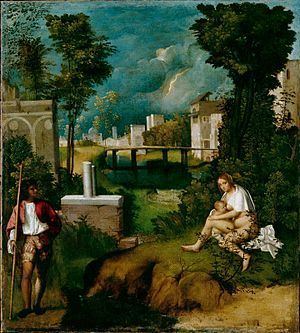Year c. 1508 Media Oil paint | Medium oil on canvas Created 1506–1508 Genre History painting | |
 | ||
Dimensions 83 cm × 73 cm (33 in × 29 in) Similar Giorgione artwork, High Renaissance artwork, Oil paintings | ||
Giorgione the tempest
The Tempest (Italian La Tempesta) is a Renaissance painting by Italian master Giorgione dated between 1506 and 1508. Originally commissioned by the Venetian noble Gabriele Vendramin, the painting is housed in the Gallerie dell'Accademia of Venice, Italy.
Contents
Giorgione s the tempest
Overview
On the right a woman sits, suckling a baby. The woman has been described as a "Gypsy" since at least 1530, and in Italy, the painting is also known as La Zingara e il Soldato ("The Gypsy woman and the soldier"), or as La Zingarella e il Soldato ("The Gypsy girl and the soldier"). Her pose is unusual - normally the baby would be held on the mother's lap; but in this case the baby is positioned at the side of the mother, so as to expose her pubic area. A man, possibly a soldier, holding a long staff or pike, stands in contrapposto on the left. He smiles and glances to the left, but does not appear to be looking at the woman. Art historians have identified the man alternatively as a soldier, a shepherd, a gypsy, or a member of a club of unmarried men. X-rays of the painting have revealed that in the place of the man, Giorgione originally painted another female nude. One may also note the stork on the rooftop on the right. Storks sometimes represent the love of parents for their children.
The painting's features seem to anticipate the storm. The colors are subdued and the lighting soft; greens and blues dominate. The landscape is a not a mere backdrop, but forms a notable contribution to early landscape painting. The painting has a 'silent' atmosphere which continues to fascinate modern viewers.
There is no contemporary textual explanation for The Tempest, and ultimately, no definitive reading or interpretation. To some it represents the flight into Egypt; to others, a scene from classical mythology (possibly Paris and Oenone; or Iasion and Demeter) or from an ancient Greek pastoral novel. According to the Italian scholar Salvatore Settis, the desert city would represent the Paradise, the two characters being Adam and Eve with their son Cain: the lightning, as in ancient Greek and Hebrew times, would represent God who has just ousted them from Eden. Others have proposed a moral allegorical reading, or concluded that Giorgione had no particular subject in mind.
In popular culture
Czech poet Ladislav Novák wrote a poem called Giorgione's Tempest where Meister Eckhart explains its symbolism in a wealthy man's study. According to him, the man is a shepherd who represents Giorgione and the lady is a woman the painter loves, without hoping his love will be requited.
In Mark Helprin's 1991 novel A Soldier of the Great War the protagonist claims the painting as his favorite and it plays a central role in the plot. It is viewed by the main characters who visit the painting in Venice and is referred to several times throughout the novel.
This was Lord Byron's favorite painting because the ambiguity of both its subject matter and symbolism allowed viewers to make up their own tale.
Jan Morris wrote that the picture changed the way she looked at painting. She was fascinated with the subject and "its sense of permanently suspended enigma", and calls it a "haunted picture", inhabited by the actual presence of the artist.
In The Wake by Neil Gaiman, the painting is depicted hanging in the dining room of the Dream King.
